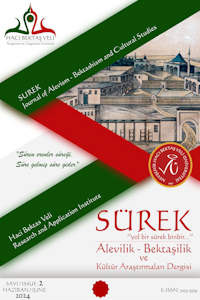Research Article
Book Review
Issue Reviewers








 Web
Web









1986 yılında Batman’ın Gercüş ilçesine bağlı Koçak köyünde doğdu. 2009 yılında Balıkesir Üniversitesi Fen-Edebiyat Fakültesi Türk Dili ve Edebiyatı bölümünden mezun oldu. 2011 yılında Erzurum Atatürk Üniversitesi, Edebiyat Fakültesi, Türk Dili ve Edebiyatı Bölümünde araştırma görevlisi olarak göreve başladı. 2012 yılında “Tâli’î’nin Farsça Divanı ve Necâtî Bey Divanı ile Mazmunlar Açısından Mukayesesi” başlıklı tezi ile yüksek lisans, 2016 yılında “Ali Nihanî’nin Manzum Hacı Bektaş-ı Veli Velayetnamesi” başlıklı teziyle de Doktora eğitimini, Atatürk Üniversitesi, Sosyal Bilimler Enstitüsü, Eski Türk Edebiyatı Bilim dalında tamamladı. 2017 yılında Muş Alparslan Üniversitesi Fen-Edebiyat Fakültesi Türk Dili ve Edebiyatı bölümüne Yardımcı Doçent olarak atandı. 2020 yılında doçentlik unvanı almaya hak kazandı. Ali Nihanî’nin Manzum Hacı Bektaş-ı Veli Velayetnamesi (2018), Atûfî-İbret-nâme (2019), Hâcibî-Şerh-i Kasîde-i Lüccetü’l-Esrâr (Özgür Kıyçak ile birlikte) (2020) adlı kitapları ile klasik Türk edebiyatı üzerine yazmış olduğu kitap bölümleri ve çeşitli dergilerde yayımlanmış makaleleri bulunmaktadır. Halen Muş Alparslan Üniversitesi, Fen-Edebiyat Fakültesi, Türk Dili ve Edebiyatı bölümünde araştırmalarını sürdürmektedir.


Aim & Scope
The aim of SUREK Journal of Alevism-Bektashism and Cultural Studies is to contribute to the scientific knowledge with interdisciplinary studies at high academic standards in the field of contemporary cultural sciences, especially Alevism-Bektashism, to revise the existing knowledge, to support the power of free scientific thought with a global perspective, to deepen the problematics, to assist the development of social organizations, professional organizations and researchers at national and international levels, to follow the developments in the field of Alevism-Bektashism and cultural research, and to make visible and disseminate studies by creating academic resources in these fields.
The journal publishes interdisciplinary, original scientific studies within the framework of cultural research on all fields of social sciences, especially Alevism-Bektasism research. Studies such as research, case presentation, compilation, thesis publication, translation, transfer and book review in the field of cultural sciences related to Alevism-Bektashism; It also publishes reviews of scientific publications in this field. The journal expects original and critical contributions at the intersection of Alevism-Bektashism cultural sciences, including international and local academic discussions in scope. Within the scope of cultural sciences, traditional arts, folk life, literature, cultural history, material culture studies, performance studies, narratives, urban-village culture, online communities, traditions cover the topics the journal is interested in. Especially within the framework of Alevism-Bektasism, beliefs, lifestyles, hearths, rituals, sacred places, cults, etc. The topics constitute the focus of the journal.
Author Guidelines
Writing Rules
Articles submitted to SUREK Journal for publication must include a title in Turkish and English, an "Abstract" in Turkish and an "Abstract" in English. The Turkish Abstract should be at least 150 and at most 200 words. References, figures, charts, etc. should not be included in the abstract. A sufficient number of keywords (at least 3 and at most 5) describing the article should be given below the abstract. If the article is written in another language, Turkish translations of the title and Abstract should be provided. Turkish and English Abstracts should include the purpose, methodology and results of the study. The article submitted to the journal should be at least 4,000 and at most 10,000 words including abstract, abstract, references, references and appendices. APA should be used as the citation system in the article. Footnotes should never be used in citation system. Footnotes should be used for explanations only when necessary and footnotes should be numbered. In terms of spelling and punctuation, the current Spelling Guide of the Turkish Language Association should be taken as a basis, except in mandatory cases required by the text. Articles uploaded to the journal system should be prepared in Microsoft Word program and should be organized in accordance with the following values:
Paper Size A4 Vertical
Top Gap 2,5 cm
Bottom Gap 2,5 cm
Left Gap 2,5 cm
Right Gap 2,5 cm
Font Garamond
Font Style Normal
Font Size (Title and Text) 11
Font Size (Summaries) 10
Font Size (Footnote) 10
Table-Graph 10
Paragraph Spacing 6 pt before, 6 pt after
Line Spacing Single (1)
• In studies where a font that is not available in the Microsoft Word program is used, the font file must be uploaded to the system along with the article.
• Articles should not include details such as page numbers, headers and footers.
• Makalelerde sayfa numarası, üst bilgi ve alt bilgi gibi ayrıntılara yer verilmemelidir.
• All subheadings, including the title of the article, are in bold and each word in the title only the first letter should be capitalized.
• An Extended Summary in English should be included at the end of the manuscript. Extended Summary should not include subheadings. Extended Summary section provide readers with information about the entire study (purpose, methodology, findings and conclusions, etc.). Extended Summary should start on a new page and should be 750-1000 words. This section should be carefully written in terms of grammar, expression and scope.
• There must be a bibliography at the end of the article. The references should be listed alphabetically according to the surnames of the authors.
• For articles written in Arabic, Persian or Russian, a bibliography in Latin is mandatory.
ARTICLE TEMPLATE
TURKISH TITLE
Garamond, 12-point font, plain, bold, centered, capitalize the first letter of each word and single (1) line spacing.
ENGLISH TITLE
Garamond, 11-point font, plain, bold, centered, capitalize the first letter of each word and single (1) line spacing.
Abstract (English / Original language)
The abstract should include a brief summary of the main parts of the article (purpose, significance, method, findings, discussion, conclusion and recommendations). The abstract should be at least 150 and at most 200 words. It should be typed in Garamond font, 10 pt, plain, justified and single (1) line spacing.
Keywords: Keywords must be compatible with English keywords. The above rules for keywords also apply to “Anahtar Kelimeler”.
Abstract (Türkçe)
Abstract, Öz ile tutarlı olmalıdır. Öz için yukarıda belirtilen kurallar Abstract için de geçerlidir. Garamond yazı karakteriyle 10 punto, düz, iki yana yaslı ve tek (1) satır aralığı olmalıdır. Öz için aranan kelime sınırı Abstract için geçerli değil. Abstract da Öz gibi tek paragraftan oluşmalıdır.
Keywords: Keywords, Türkçe anahtar kelimeler ile uyumlu olmalıdır. Anahtar kelimeler için yukarıda verilen kurallar keywords için de geçerlidir.
Introduction
The Introduction should not be numbered. Headings and subheadings after the introduction should be numbered hierarchically. The first letter of each word in headings and subheadings should be capitalized. Headings and the whole text should be in Garamond font. However, if special fonts are used in some studies, these fonts should be uploaded to the system with the article.
The title of the introduction should be written in 11 pt, bold, plain, centered. There should be 6 spaces before and 6 spaces after the title of the introduction.
There should be 6 spaces before paragraphs and 6 spaces after paragraphs. Paragraph beginnings should be 1 cm in from the left and justified. Line spacing should be "single" throughout the text. Page margins should be "Normal" (bottom, top, right, left 2.5 cm).
1. First Level Title
First level headings should be written in 11 pt, plain, bold and 1 cm from the left. The first letter of each word should be capitalized. There should be 6 spaces before the first-level heading and 6 spaces after the heading. First-level headings can be used as many times as necessary.
There should be 6 spaces before and after paragraphs. The text should be written in Garamond typeface, 11 pt. font, plain and justified.
1.2. Second Level Title
Second level headings should be 11 pt, plain, bold and 1 cm from the left. The first letter of each word should be capitalized. There should be 6 spaces before and after the second level heading. Second-level headings can be used as many times as necessary.
There should be 6 spaces before and after paragraphs. The text should be written in Garamond typeface, 11 pt. font, plain and justified.
1.2.1. Third Level Title
Third level headings should be in 11 pt, italicized and 1 cm from the left. The first letter of each word should be capitalized. There should be 6 spaces before and after the third level heading. Third-level headings can be used as many times as necessary.
There should be 6 spaces before and after paragraphs. The text should be written in Garamond typeface, 11 pt. font, plain and justified.
Citations
In direct quotations, the quotation is included in the study without changing the main idea, form and content. Quotations of less than 40 words are written in quotation marks ("") and with normal line spacing. Unless the original source contains ellipses, ellipses should not be added at the beginning and/or end of the quotation.
Quotations in the text should be enclosed in double quotation marks (See Quote 1.) and (See Quote 2.). However, if there are expressions given in double quotation marks in the original text of the quoted text, these quotations should be shown in single quotation marks. (See Quotation 1., Quotation 2. and Quotation 3.) When closing the quotation marks, punctuation marks that are parts of the original text should be used in the quotation; in cases where they are not parts of the original text, only periods and/or commas should be used.
Citation 1:
In his article on this subject, the author states that "determining the existence of semah within the framework of the Safavid State, revealing its place and characteristics is also important for today's Alevism and Bektashism and Safavid history research." (Baharlu, 2021, p. 12).
Citation 2:
Baharlu (2021) made the following statement: "It is known that the Ardabil Tekke, which was in close contact with the Anatolian Alevi and Bektashi communities in the 15th and 16th centuries, and the Safavid State, which came from this tekke, had serious mutual influences on Anatolian Alevism and Bektashism" (p. 13).
Quotations of 40 words or more are formatted as a block quotation in the form of a condensed paragraph. For this purpose, the block quotation should start on a new line and be indented 2 cm on both sides, left and right. The entire quotation should be single-spaced. Quotation marks are not used for block quotations. Any quotation within a block quotation must be indicated with double quotation marks.
Block Citation:
Shah Ismail (may Allah make the basis of his justice permanent and may Allah forgive him on the Day of Religion), the authority of sovereignty, the shareholder of government, the dome of glory, the return of bliss, the descendant of seyyidism, the fighter for sovereignty and government and the glory and prosperity, has sent his holiness Shah Ismail (may Allah make the basis of his justice permanent and may Allah forgive him on the Day of Religion) with a face of love and purity of intention, and the wonderful greetings and prayers he has sent have been dedicated and directed by the caravans of those who pray the prayer in the morning and the fast camels of those who recite dhikr day and night, Let them know that the kindness of the sultan's sake is directed and spent on your blissful side, and let them always be interested in asking about their good deeds and receiving news (Baharlu, 2023, p. 12).
Other Types of Citation:
(TSMA, E 6321).
(Hoca Sadettin Efendi, Atasofya Kol., No 3041, vrk. 35).
(Mühimme Defteri 85, hk. 151).
Tables, Figures and Visuals
Tables and figures should be included in the relevant text. All tables and figures should be numbered consecutively. They should be referred to as (Table 1), (Figure 1) in the text. An appropriate short definition should be used for each table and figure and the definition should be below the Table/Figure heading and above the table/figure. In addition, if the table or figure is taken from another source, the source information should be included.
Tables and figures should start from the left at the paragraph level. Table/Figure titles should be in 10 pt. and bold. The description of the table/figure should be in 10 pt. and normal. If the tables and figures do not fit within the margins specified for the Journal, then the tables and figures should be placed as images (.jpeg, .png) within the text.
All kinds of visuals such as paintings, photographs, graphics, posters, etc. should be organized according to the criteria set for tables and figures.
Conclusion
The Conclusion should be unnumbered like the Introduction. Conclusion title should be written in 11 pt, bold, plain, centered. There should be 6 spaces before and 6 spaces after the conclusion title.
There should be no space before paragraphs and 6 spaces after paragraphs. Paragraph beginnings should be 1 cm in from the left and justified.
Bibliography
The bibliography should be created according to the Journal Writing Rules.
Statement of Research and Publication Ethics (Mandatory Statement)
In this section, the statement of the author(s) regarding research and publication ethics will be included. This heading must be included for all articles. For example;
Researchers declare that they pay attention to all ethical principles and rules in the collection, analysis and reporting of data.
Contribution Rates of Authors to the Article (Mandatory Declaration)
In this section, for single-authored articles, the author's statement that he/she prepared the article alone, and for multi-authored articles, information on the contribution rates of all authors separately. This heading must be included for all articles. For example;
The article was prepared with a single author.
The authors contributed equally to the study.
1st author contributed 60%, 2nd author contributed 40%.
Declaration of Interest (Mandatory Declaration)
In this section, authors' declarations regarding conflict of interest will be included. This heading must be included for all articles. For example;
There is no conflict of interest between the authors.
Support and Acknowledgement (If any, not required)
If support has been received from any institution or organization, information about the support received (name of the institution, project number, etc.) should be provided. (Non-mandatory statement)
Information about the people or institutions that the authors would like to thank should be provided (Non-mandatory statement)
Ethics Committee Permission
For articles that require Ethics Committee Approval, this issue should be stated both in the title with a footnote and in the text in the method section. It should be briefly stated in one sentence from which institution and on which date the Ethics Committee Report was obtained for the study.
Appendix
If there are appendices in the study, they can be given under this heading.
CREATING A BIBLIOGRAPHY
Periodicals
Journal Article References
Scientific/Academic Journal Article
Single Authored Article in Periodicals
Template: Author's surname, Author's Initial. (Year). Title of the article. Name of Periodicals, Volume (Issue), Page range. http://doi.org/xx.xxxxxxxxxx
Examples:
Akın, E. (2021). Sanal ortamda veli kültünün yeniden inşası: Hacı Bektaş Veli örneği. Nevşehir Hacı Bektaş Veli Üniversitesi Sosyal Bilimler Enstitüsü Dergisi, Hacı Bektaş Veli Özel Sayısı, 118-134. https://doi.org/10.30783/nevsosbilen.1007433
Baharlu, İ. (2021). Safevi dönemi Kızılbaş Türkmen toplumunda kadın (Bir Kızılbaş kadın örneği Taçlı Begüm). TUDED Türk Dili ve Edebiyatı Dergisi, 61(1), 339-355. https://doi.org/10.26650/TUDED2021-918536
Barkan, Ö. L. (2015). İstila devirlerinin kolonizatör Türk dervişleri ve zaviyeler. İnsan&İnsan, 5, 5-37.
Baharlu, I. (2023). Witnessing the relationship between Sultan Bayezid II and Shah Ismail Safavid: two letters as primary sources. Journal of Alevism-Bektashism Studies, 27, 3-18. https://doi.org/10.24082/2023.abked.413
Topuz, B. (2023). Three concepts that are confused with each other in academia: Alevism, Bektashism, and Shiism. Journal of Alevism-Bektashism Studies, 27, 57-82. https://doi.org/10.24082/2023.abked.400
Note: If the article has a DOI, add the DOI to the source. If the article does not have a DOI, end the reference after the page range. In this case, the source is the same as a printed journal article.
Two Authored Articles in Periodicals
Template: First author’s surname, First author's initial. and Second author’s surname, Second author's initial. (Year). Title of the article. Name of Periodicals, Volume (Issue), Page range. http://doi.org/xx.xxxxxxxxxx
Example:
Karlıdağ, S. ve Kuşdil, M. E. (2021). Alevilerin kent yaşamındaki kimlik repertuarına sosyal psikolojik bir bakış: Etnik kimliğin, ana dilin ve grup içi temsillerin benlik kategorizasyonundaki rolü. Alevilik-Bektaşilik Araştırmaları Dergisi. 23, 43-80. https://doi.org/10.24082/2021.abked.288
Güllüpınar, F. ve Özkan, Ö. (2021). Etnografik mülakatın imkân ve sınırlılıkları üzerine: Konumsallık, etik ve inşa sorunları. Van Yüzüncü Yıl Üniversitesi Sosyal Bilimler Enstitüsü Dergisi, 54, 11-40. https://doi.org/10.53568/yyusbed.1052223
Köse, M. Z. ve Artan, M. (2021). Müslümanlar nezdinde Mehdi tasavvuru: 610-765 yılları arasında köken ve etkiye dair tespitler. Türk Kültürü ve Hacı Bektaş Veli Araştırma Dergisi, 98, 171-196. http://doi.org/10.34189/hbv.98.008.
Articles with Three or More Authors in Periodicals
Template: First author’s surname, First author's initial., Second author’s surname, Second author's initial. and Third author’s surname, Third author's initial. (Year). Name of Periodicals, Volume (Issue), Page range. http://doi.org/xx.xxxxxxxxxx
Article with Volume Number but No Issue Number
Example:
Sanchiz, M., Chevalier, A., & Amadieu, F. (2017). How do older and young adults start searching for information? Impact of age, domain knowledge and problem complexity on the different steps of information searching. Computers in Human Behavior, 72, 67–78. https://doi.org/10.1016/j.chb.2017.02.038
Article with Issue Number but not Volume Number
Example:
Öztürk, V. (2021). Method in XIX. Asır Türk Edebiyatı Tarihi: Albert Thibaudet’s Influenceon Ahmet Hamdi Tanpınar. Bilig, 99, 163-180. https://doi.org/10.12995/bilig.9907
Author with Double Surname
Example:
Biber-Vangölü, Y. (2021). Locating the European carnival in the cultural history of Britain. Milli Folklor, 17(131), 131-140. https://dergipark.org.tr/tr/pub/millifolklor/issue/66180/716895
Popular Magazine Article
Template: Author's surname, Author's Initial. (Year, Month, Date). Title of the article. Name of Periodicals, Volume(Issue), Page range. http://doi.org/xx.xxxxxxxxxx
Example:
Artan, M. (2022, Eylül). Hacı Bektaş Ocağı’nda Bir Sahib-i Huruc Şah Kalender Çelebi. Aktüel Tarih, (4), 116–119.
Newspaper Article
Printed Newspaper Article
Template: Author's surname, Author's Initial. (Year, Month, Date). Title of the article. Name of the newspaper, Page range.
Example:
Çetin, E. (1988, Şubat 18). Kadının adı yok. Milliyet, 10.
Online Newspaper Article
Template: Author's surname, Author's Initial. (Year, Month, Date). Title of the article. Name of the newspaper, URL adresi.
Example:
Kırıkkanat, M. G. (2022, Ocak 2). Yeşilçam iktidarı istiyoruz!. Cumhuriyet. https://www.cumhuriyet.com.tr/yazarlar/mine-g-kirikkanat/yesilcam- iktidari-istiyoruz-1897052
Blog Post
Template: Author's surname, Author's Initial. (Year, Month, Date). Blog title. Blog page. URL address.
Example:
Aktan, D. (2022, Şubat 4). Nefret ettiğimiz markalara neden aşık oluruz?. Harvard Business Review Türkiye. https://hbrturkiye.com/blog/nefret-ettigimiz-markalara-neden-asik-oluruz
Note: Blog posts follow the same format as magazine articles. The blog title is italicized, just like a magazine title.
Book/Book References
Single Author Book
Template: Author's surname, Author's Initial. (Year). Title of the book (Number of editions). Publisher.
Example:
Yaman, M. (2011). Alevilik; inanç, edep, erkan (3. Baskı). Demos Yayınları.
Artan-Ok, M. (2023). Türk İslam düşüncesinde Mehdilik; Osmanlı’da Şahkulu örneği (1. Baskı). Alfa Yayınları.
Ocak, A. Y. (1989). La Revolte De Baba Resul Ou La Formation De L’Heterrodoxie Musulmane En Anatolie Au XIII Siecle (1nd ed.). Türk Tarih Kurumu.
Two Authored Articles
Template: First author’s surname, First author's initial. and Second author’s surname, Second author's initial. (Year). Title of the book (Number of editions). Publisher.
Example:
Akın, B. ve Baharlu, İ. (2022). Erbâbü’t-Tarîk XVII. Yüzyıl’a Ait Bir Kalenderi Erkannamesi (Çeviri-Tıpkıbasım-İnceleme) (1. Baskı). Paradigma Akademi Yayınları.
Book with Three or More Authors
Template: First author’s surname, First author's initial., Second author’s surname, Second author's initial. and Third author’s surname, Third author's initial. (Year). Title of the book (Number of editions). Publisher.
Example:
Akın, B. ve Baharlu, İ. (2022). Erbâbü’t-Tarîk XVII. Yüzyıl’a Ait Bir Kalenderi Erkannamesi (Çeviri-Tıpkıbasım-İnceleme) (1. Baskı). Paradigma Akademi Yayınları.
Not: The same formats should be used for both printed books and e-books. For e-books, the format, platform or device (e.g. Kindle) is not included in the reference.
Chapter
Template: Author's surname, Author's Initial. (Year). Title of the Chapter. Title of the book (Number of editions, Page range) in. Publisher.
Example:
Sachedina, A. (2005). Allah’ın Velîsi ve Peygamber’in vasîsi: Oniki İmamcı Şiî inancında Ali b. Ebî Tâlib. Tarihten Teolojiye: İslam İnançlarında Hz. Ali (1. Baskı, 3-24) içinde. Türk Tarih Kurumu Yayınları.
Al-Haq Z (2006) Spiritual dimensions of Mahdism in the modern age. The Selective of the Second International Conference of the Mahdiism Doktrine (2nd ed., pp. 53-58) Bright Future İnstitute.
Chapter in Edited / Hardcover Book
Template: Author's surname, Author's Initial. (Year). Title of the Chapter. Editor's initials. Editor’s surname (Ed.), Title of the book (Number of editions, Page range) in. Publisher.
Example:
Türer, O. (2005). Osmanlı toplumunda tasavvuf ve sufiler. A. Y. Ocak (Ed.), Osmanlı Anadolu`sunda tarîkatların genel dağılımı (1. Baskı, 207-246) içinde. T.T.K. Yayınları.
Akın, B. (2020). Alevi-Bektaşi inancında taş-kaya-duvar yürütme motifi etrafında oluşan anlatılar üzerine bir anlam çözümlemesi. B. Akın (Ed.), Ritüelleri ve Anlatılarıyla Kutsal Mekânlar (Güneydoğu Anadolu Bölgesi Örneği) -I (1. Baskı, 187-229) içinde. Paradigma Yayınları.
Blake, S. P. (2016). Time as apocalypse: millenarian movements in the Safavid, Mughal, and Ottoman Empires. B. Kuşpınar (Ed.), Uluslararası İslam Medeniyetinde Zaman Sempozyumu/08-11 Ekim 2015 (1. Baskı, 19-36) içinde. (Cilt 2). Bilir Matbacılık.
Translated Book
Template: Author's surname of the original book, Author's Initial. (Year). Title of the book (Number of editions). (Translator’s Initial. Translator’s Surname, Trans.). Publisher.
Example:
Ispanakçı Paşazade, M. A. (2023). Şah İsmail ve Sultan Selim İnkılabü’l-İslam Beyne’l-Havas ve’l-Avam (1. Baskı). (N. Musalı Çev.). Bilge Kültür Sanat.
Eliade, M. (2001). Mitlerin Özellikleri (xxx. Baskı). (S. Rifat Çev). Om Yayınevi.
Eflâkî, A. (1989). Âriflerin Menkıbeleri (T. Yazıcı Çev.). (Cilt 1). Milli Eğitim Bakanlığı Yayınları.
Aşıkpaşazâde. (1332). Tevârîh-i Âl-i Osmân (Âlî Bey Neşr.). Matbaa-i Âmire.
Chapter in a Translated Book (Edited)
Template: Author's surname of the original book, Author's Initial. (Year). Title of the Chapter. Editor's initials. Editor’s surname (Ed.) and Translator’s initial. Translator’s surname (Trans.). Title of the book (Number of editions, Page range) in. Publisher.
Example:
Crow, D. S. (2003) İslamî Mesihçilik. Ali Çoşkun (Çev.). Mesih’i Beklerken Mesihçi ve Millenarist Hareketler- Temel Giriş Metinleri- (1. Baskı, s. 65-75) içinde. Rağbet Yayınları.
Religious Book
Template: Title of the book. (Year). (Translator’s Initial. Translator’s Surname, Trans.). Publisher.
Kur’ân-ı Kerîm. (2019). Diyanet İşleri Başkanlığı Yayınları.
Kur’ân-ı Kerîm Meâli. (2009). (3. baskı). (H. Altuntaş, M. Şahin, Çev.). Diyanet İşleri Başkanlığı Yayınları.
Kur’ân-ı Kerîm. https://kuran.diyanet.gov.tr/mushaf/kuran-2/fatiha-suresi-1/ayet-1/diyanet-vakfi- meali-4
Kitabı Mukaddes. (2003). Kitabı Mukaddes Şirketi.
Kutsal Kitap: Tevrat, Zebur İncil. (2009). Kitabı Mukaddes Şirketi - Yeni Yaşam Yayınları.
King James Bible. (2017). King James Bible Online. https://www.kingjamesbibleonline.org/ (Original work published 1769)
Annotated Religious Book
Template: Author's surname of the original book, Author's Initial. (Year). Title of the book (Number of editions). (Translator’s Initial. Translator’s Surname, Trans.). Publisher.
Example:
Esed, M. (2002). Kur’an mesajı: Meal-tefsir. (C. Koytak ve Ah. Ertürk, Çev.). İşaret Yayınları.
Öztürk, M. (2011). Kur’ân-ı Kerîm meâli (anlam ve yorum merkezli çeviri). (3. baskı). Düşün Yayınları.
Kaiser, W. C., Jr., & Garrett, D. (Eds.). (2006). NIV archeological study bible: An illustrated walk through biblical history and culture. Zondervan.
Printed Dictionary
Template: Author's surname, Author's Initial. (Year). Title of the book (Number of editions). Publisher.
Example:
Karataş, T. (2019). Ansiklopedik edebiyat terimleri sözlüğü (4. baskı). İz Yayıncılık.
Online Dictionary
Example:
Güncel Türkçe Sözlük. (t.y.) Türk Dil Kurumu. https://sozluk.gov.tr/transfer?option=com_gts&view=gts
Kubbealtı Lugati. (t.y.). Kubbealtı Akademisi. http://lugatim.com
Wikipedia
Template: Article title (date the article was archived). Wikipedia in. URL address.
Example:
Kızılbaş (2023, Aralık 7). In Wikipedia
https://tr.wikipedia.org/wiki/K%C4%B1z%C4%B1lba%C5%9F
Şahkulu rebellion (2023, December 7). In Wikipedia. https://en.wikipedia.org/wiki/%C5%9Eahkulu_rebellion
Note: When citing Wikipedia, an archived version of a Wikipedia page must be cited so that readers can retrieve the version used. The archived version on Wikipedia should be accessed by selecting "View history" followed by the time and date of the version used. If a wiki does not provide permalinks to archived versions of the page, the URL and date of the entry should be included.
Interview/Reportage
Template: Interviewer's last name, Name initial (date). Interview title. Interview with the interviewee. Publication name, Volume (Issue), page range.
Şahin, H. (2014). Ahmet Yaşar Ocak’la söyleşi. Arı kovanına çomak sokmak: taşra kökenli bir tarihçinin sıradan meslek hayatı. Timaş Yayınları.
Öztürk, S. R. (2006). Beni korkutan, bana acı veren belirsizliktir. Zeki Demirkubuz’la söyleşi. S. R. Öztürk (Ed.), Kader: Zeki Demirkubuz (s. 79-121). Dost.
Symposium/Conference Proceedings
Template: Author's surname, Author's Initial. (Year). Title of the Proceedings. Proceedings Book. (Number of editions, Page range). Name of the Symposium.
Example:
Akman, A. (2019). Ahret kardeşliği geleneği ve Trakya bölgesinin bazı yerlerinde evlenme geleneklerine yansımaları. Gelenek görenek ve inançlar. 9. Milletlerarası Türk halk kültürü kongresi bildirileri 2018. (1. Baskı, 63- 77) içinde. Kültür ve Turizm Bakanlığı Araştırma ve Eğitim Genel Müdürlüğü Yayınları.
Aksoy, M. (1997). Türkiye’de kirveliğin kültür sosyoloji açısından tahlili. V. Milletlerarası Türk halk kültürü kongresi, gelenek, görenek, inançlar seksiyonu bildirileri (1. Baskı, 44- 52) içinde. Ankara: Kültür Bakanlığı Yayınları.
Yücel Çetin, A. ve Çetin, İ. (2015). Mahtumkulu düşüncesinde Türklük. A. Güzel (Ed)., Uluslararası Türkmen Şairi Mahtumkulu Firaki Sempozyumu Bildiri Kitabı (1. Baskı, 82-88) içinde. Başkent Üniversitesi
Oral Presentation Template: Author's surname, Author's Initial. (Year). Title of the Proceedings. Proceedings Book. (Number of editions, Page range). Name of the Symposium.
Boz, E. ve Yıkımış, S. (2021, Temmuz 12-14). Yunus Emre’de empati dili [Sözlü sunum]. Yunus Emre’nin Vefatının 700. Yıl Dönümü Anısına Uluslararası Türkçenin Anadolu’da Yazı Dili Oluşu Sempozyumu, Ankara, Türkiye.
Akın, B. ve Baharlu, İ. (2022, Eylül 16-17). İki Kalenderiye Erkannâmesi ve Alevi Ritüelleri ile ortaklıları [Sözlü sunum]. 3. Alevi Ritüelleri Sempozyumu, İzmir, Türkiye.
Note: The presentation should be described in square brackets after the title. The description is flexible (e.g. "[Conference session]", "[Paper presentation]", "[Poster presentation]", "[Keynote speech]"). If a video of the conference presentation is available, it can be included as a link at the end of the reference.
Note: Conference proceedings published in a journal follow the same format as journal articles. Papers published as a book follow the same reference format as edited books.
Thesis
Published Thesis
Template: Author's surname, Author's Initial. (Year). Title of the Thesis (Thesis No.) [Master's disssertation
/ Doctoral dissertation, University name]. Published database / Internet address.
Ersal, M. (2013). Alevi-Bektaşi inanç sisteminde hiyerarşik yapı: Çubuk havzası Aleviliği örneği (Tez No. 349167) [Doktora tezi, Ege Üniversitesi]. Yükseköğretim Kurulu Ulusal Tez Merkezi.
Note:A thesis is considered published when it is accessible from a database such as ProQuest Dissertations & Theses Global or PDQT Open, Council of Higher Education National Thesis Center, an institutional repository or an archive. If the database assigns publication numbers to theses and dissertations, the publication number should be written in parentheses after the title of the thesis or dissertation, without italics.
UnPublished Thesis
Template: Author's surname, Author's Initial. (Year). Title of the Thesis [Unpublished Master's disssertation
/ Doctoral dissertation]. University name.
Example:
Çobanoğlu, Ö. (1992). The relationships between oral forms of folklore and mediated performances in the cult of Çakıcı Mehmet Efe [Unpublished master dissertation]. Indiana University.
Audiovisual Media
Film and Television Reference
Film
Template: Director's surname, Director's Initial (Director) (Year). Title of the film [Film]. Producing Company; Producing Company.
Example:
Seyidbeyli, H. (Yönetmen). (1973). Nesimi [Film]. Azerbaycan Film.
Note: If there is more than one production company in the reference's source element, they should be separated by semicolons.
TV Series
Template: Producer's surname, Producer's Initial (Producer) (Year(s) the series was broadcast).
Title of the TV Series [TV Series]. Producing Company.
Example:
Kayis, E. (Yapımcı). (2020-2022). Alef [TV dizisi]. May prodüksiyon.
Note: If the series is still airing, the second year should be replaced by "present" (2017-present). If there is more than one production company in the source element of the reference, they should be separated by semicolons.
Main Sources
Example:
Topkapı Sarayı Müzesi Arşivi. E 6321.
Hoca Sadeddin Efendi. Tâcü’t-Tevârîh, Süleymaniye Kütüphanesi, Ayasofya Kol., No 3041.
Başbakanlık Osmanlı Arşivi. Mühimme Defteri 85. hüküm 151.
Note: The main sources consist of both chronicles and archival sources. The abbreviations used in the text are based on the abbreviations in the Prime Ministry Ottoman Archive. The same will be the case for other main sources.
Encyclopedia Article
Example:
Fığlalı, E. R. (1996). Gadîr-i Hum. TDV İslâm Ansiklopedisi (Cilt 13, 279-280) içinde. TDV Yayınları.
Emmet, C. W. (1916). Messiah. James Hastings (Ed.), Encyclopaedia of Religion and Ethics. (Volume 8, 570-581) içinde. Charles Scribner’s Sons.
Ethical Principles and Publication Policy
Ethical Principles and Publication Policy
Publication Ethics
SUREK Journal of Alevism-Bektashism and Culture Research (SUREK for short), a publication of Hacı Bektaş Veli Research and Application Institute of Nevşehir Hacı Bektaş Veli University, takes care to publish in accordance with the guidelines and policies of the Committee on Publication Ethics (COPE) in open access (e.g. "Committee on Publication Ethics (COPE) Code of Conduct and Best Practice Guidelines for Journal Editors; "Code of Conduct and Best Practice Guidelines for Journal Editors" and "COPE Best Practice Guidelines for Journal Editors"). SUREK Journal follows the basic practices of the Committee on Publication Ethics (COPE) in the context of ethics (Authorship and Contribution; Conflict of interest; and Journal management) and carefully follows the resources provided by the Committee on Publication Ethics (COPE) in order to achieve international standards in ethics.
Ethical Responsibilities of SUREK Journal
The editor-in-chief and editors of SUREK Journal meticulously review submitted manuscripts for compliance with ethical principles. They take serious measures to identify and prevent the publication of manuscripts in which research misconduct has occurred and thus do not encourage or knowingly allow such misconduct to occur. If the editor-in-chief and editors of SUREK Journal detect any violation of ethical principles (such as manipulation of the data used and the use of fabricated data), this will be officially notified to the institution to which the author(s) of the article is affiliated. The article will not be accepted for publication. SUREK Journal and its editor-in-chief and editors are always ready to publish corrections, clarifications, retractions and apologies when necessary.
The author(s) have the right to request a retraction or correction at any time before their article is published. However, they can only request the withdrawal or correction of their articles within five days after the publication of their articles in an issue. SUREK Journal has the right to make corrections in the submitted articles, to publish or not to publish the articles. The copyrights of the articles sent to SUREK for publication are transferred to the journal. These articles cannot be published, reproduced or used in any other publication organ without permission from the journal management. No royalties are paid to the author(s) for the published articles. In addition, article application fee and publication fee are not charged from the author/authors. The legal, scientific and ethical responsibility of the articles published in the journal belongs to the author(s). The Editorial Board and the editorial team do not accept any legal liability that may arise.
Ethical Responsibilities of the Editor-in-Chief and Editors
The editor-in-chief and editors of SUREK are responsible for everything published in the journal, including choosing which articles to publish. The editorial board and editors of the journal guide the editor-in-chief in making these choices, and the editor-in-chief also takes into account the editorial policies of the journal in this process. In the selection of articles to be published, the editor-in-chief and the editors evaluate them based on their intellectual content, regardless of the gender, race, ethnicity, religion, citizenship and political values of the author(s). The editor-in-chief and editors of SUREK Journal never discriminate between author(s) and/or reviewers based on personal characteristics or identity. On the contrary, it accommodates diversity and promotes equality at every stage of evaluation and publication. The editor-in-chief and editors of SUREK Journal do not allow anyone to use unpublished material and other information and data in the texts submitted to the journal by the author(s) in their own work without the express and written permission of the author(s). As can be understood from the above-mentioned statements, the editor-in-chief and editors of SUREK Journal strictly comply with the conflict of interest, impartiality, confidentiality and other issues set out in COPE.
Ethical Responsibilities of Referees
Referees who are asked to review/evaluate by the editor-in-chief and editors of SUREK Journal may refuse to serve as a referee if they do not find the work assigned to them relevant to their field, if they do not feel competent to criticize it, or if they cannot provide a timely evaluation.
The manuscripts that the referees will evaluate are confidential files. For this reason, Referees should not show the articles to anyone other than authorized persons and should not discuss the articles. Information and ideas obtained during the refereeing process should not be used for personal gain.
Refereeing should be conducted in an objective, fair and scientific ethical manner. Referees should not criticize the author(s) personally and should avoid derogatory personal comments such as slander and insult. Referees should evaluate manuscripts regardless of the origin, gender or political philosophy of the author(s). Referees should also ensure a fair blind review process for the evaluation of manuscripts submitted to the journal.
During the refereeing process, if the referees notice a substantial similarity or overlap between the manuscript they are reviewing and another manuscript, they should report this immediately to the editor-in-chief and editors.
Referees should not review manuscripts where they know or can guess the author(s) or where there are conflicts of interest that may arise from competition, collaboration, or other relationships or connections between them.
During the refereeing process, referees should assist the editor-in-chief and editors in revising and/or publishing manuscripts and should also assist the author(s) to improve the quality of the manuscript.
Ethical Responsibilities of the Author(s)
Articles submitted to SUREK Journal must be original. Articles must not have been previously published in another journal or submitted for evaluation in another journal. It is unethical and unacceptable to submit the same manuscript to more than one journal at the same time. It is extremely important that the author(s) pay attention to these issues. The author(s) submitting an article to SUREK Journal are deemed to have undertaken the above issues. The data used in the study should be presented meticulously in the study. A study should contain sufficient detail and source information. Fraudulent and deliberate misrepresentations are unacceptable as they may lead to unethical situations. In addition, the author(s) should strictly follow the journal's spelling rules. The author(s), referee, editor-in-chief, editors, editors, language should meticulously carry out the changes requested by the editor. Additional documents requested by the editor-in-chief, editors or referees should be uploaded to the system. In cases where the requested changes are not made within the given deadlines, the manuscripts will be returned to the author(s) to be re-evaluated.
The author(s) may be asked to provide relevant raw data in connection with their work that may be needed at the review stage, so they should be prepared to provide access to this data and retain it for a reasonable period following publication of their work.
The author(s) should prove that their work is original and complies with ethical standards with documents. In this context, the author(s) should make direct or indirect citations according to APA standards and include the sources they cite in the bibliography section. In addition, the author(s) must prove that the similarity rate of their work is below 20% with the Identicate report while uploading their work to the system.
The author(s) who published in SUREK Journal can publish again after one year as per the journal policy. In addition, in any issue of SUREK Journal, a maximum of 25% of the number of publications can be made by academic staff of Nevşehir Hacı Bektaş Veli University.
The author(s) submitting a study to SUREK Journal should list the authors who contributed to the study after the first author in proportion to their contribution. In addition, authors are obliged to declare that there is no conflict of interest between them. Corresponding authors or author ranks of the articles whose evaluation process has ended cannot be changed.
The ethical principles that authors submitting articles to SUREK Journal should also comply with are as follows: Articles submitted to SUREK Journal for evaluation must not have been published in another journal or submitted for evaluation. All sources used in the submitted articles must be cited in accordance with scientific research methods and ethical principles. Authors should be listed in order of their contribution. The work of the author(s) must be original and the similarity rate must be below 20%. There must be no ethical violations regarding the participants used in the study. Ethical permissions must have been obtained in accordance with the "Higher Education Council Scientific Research and Publication Ethics Directive" and an ethics report must have been submitted. For articles that do not require an ethics report, the author(s) are responsible for signing the document indicating that their work does not require an ethics report and sending it to the journal's e-mail. If the submitted work is an article derived from a thesis or a paper previously presented at a conference, it should be indicated in the author information form.
The author(s) agrees to transfer the financial rights on the works they submit to the journal, in particular the rights of processing, reproduction, representation, printing, publication, distribution and all kinds of public communication, including transmission via the internet, to SUREK Journal for unlimited use and are responsible for sending the wet signed version of the copyright transfer form in the system to the journal's e-mail. Regarding the work, SUREK Journal has no responsibility for any claims or lawsuits to be filed by third parties due to copyright infringement, and the responsibility belongs entirely to the author(s). Authors are obliged to comply with the journal's publication policy, ethics and writing rules.
Authors must agree to make necessary corrections in line with the suggestions of the editor-in-chief, editors and referees during the publication process. In this context, if the author or authors do not accept the suggestions made to them, the article in question will be rejected. In co-authored articles, if the other authors cannot be reached, the responsible author is deemed to accept full responsibility. The use of articles published in the journal in other studies is possible only if citation is given. Research involving humans or animals must be approved by the relevant ethics committee(s). Articles must comply with international ethical and legal standards. Authors are also required to respect the confidentiality rights of human participants and to obtain any necessary permission for publication before submitting an article to SUREK Journal.
Ethics committee report is mandatory for all candidate articles whose publication process starts in 2020 and later. The ethics committee report must be sent as an attachment when submitting the candidate article. For candidate articles that do not require ethics committee approval, the author declaration form stating that ethics committee approval is not required must be signed and scanned by the corresponding author.
Price Policy
Hiçbir ad altında yazar veya kurumundan ücret alınmaz.

